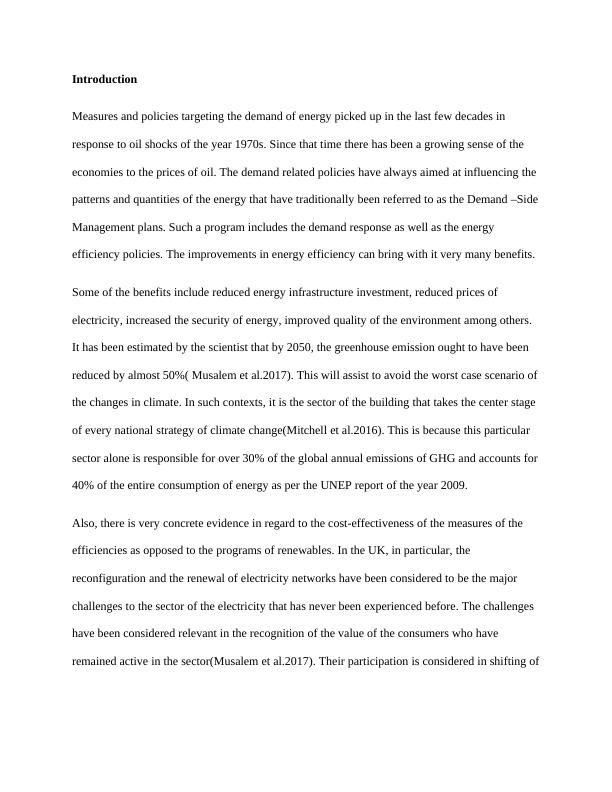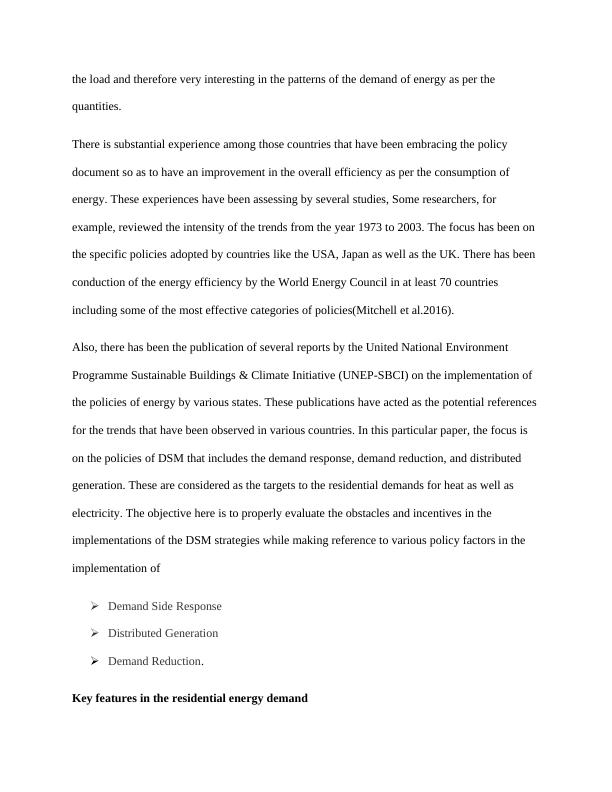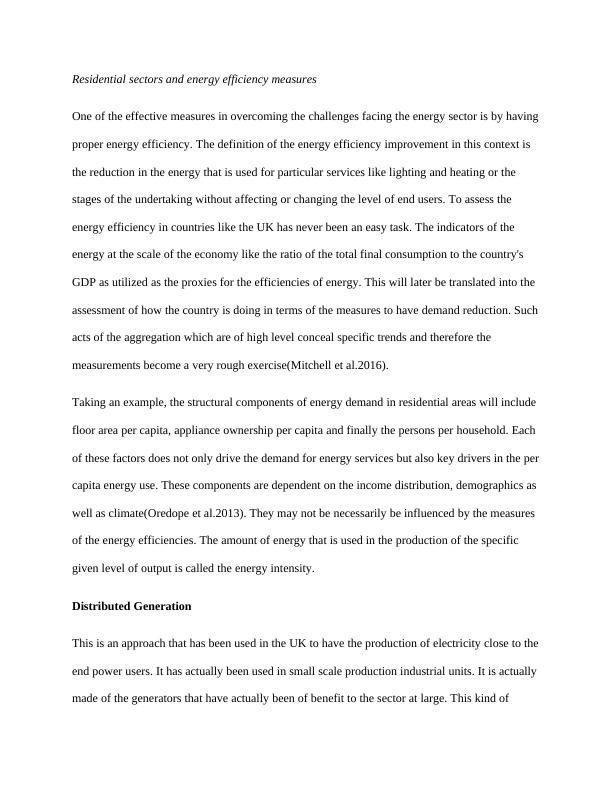Managing Energy Resources
Added on 2023-01-18
15 Pages3505 Words43 Views
MANAGING ENERGY RESOURCES
By Name
Course
Instructor
Institution
Location
Date
By Name
Course
Instructor
Institution
Location
Date

Introduction
Measures and policies targeting the demand of energy picked up in the last few decades in
response to oil shocks of the year 1970s. Since that time there has been a growing sense of the
economies to the prices of oil. The demand related policies have always aimed at influencing the
patterns and quantities of the energy that have traditionally been referred to as the Demand –Side
Management plans. Such a program includes the demand response as well as the energy
efficiency policies. The improvements in energy efficiency can bring with it very many benefits.
Some of the benefits include reduced energy infrastructure investment, reduced prices of
electricity, increased the security of energy, improved quality of the environment among others.
It has been estimated by the scientist that by 2050, the greenhouse emission ought to have been
reduced by almost 50%( Musalem et al.2017). This will assist to avoid the worst case scenario of
the changes in climate. In such contexts, it is the sector of the building that takes the center stage
of every national strategy of climate change(Mitchell et al.2016). This is because this particular
sector alone is responsible for over 30% of the global annual emissions of GHG and accounts for
40% of the entire consumption of energy as per the UNEP report of the year 2009.
Also, there is very concrete evidence in regard to the cost-effectiveness of the measures of the
efficiencies as opposed to the programs of renewables. In the UK, in particular, the
reconfiguration and the renewal of electricity networks have been considered to be the major
challenges to the sector of the electricity that has never been experienced before. The challenges
have been considered relevant in the recognition of the value of the consumers who have
remained active in the sector(Musalem et al.2017). Their participation is considered in shifting of
Measures and policies targeting the demand of energy picked up in the last few decades in
response to oil shocks of the year 1970s. Since that time there has been a growing sense of the
economies to the prices of oil. The demand related policies have always aimed at influencing the
patterns and quantities of the energy that have traditionally been referred to as the Demand –Side
Management plans. Such a program includes the demand response as well as the energy
efficiency policies. The improvements in energy efficiency can bring with it very many benefits.
Some of the benefits include reduced energy infrastructure investment, reduced prices of
electricity, increased the security of energy, improved quality of the environment among others.
It has been estimated by the scientist that by 2050, the greenhouse emission ought to have been
reduced by almost 50%( Musalem et al.2017). This will assist to avoid the worst case scenario of
the changes in climate. In such contexts, it is the sector of the building that takes the center stage
of every national strategy of climate change(Mitchell et al.2016). This is because this particular
sector alone is responsible for over 30% of the global annual emissions of GHG and accounts for
40% of the entire consumption of energy as per the UNEP report of the year 2009.
Also, there is very concrete evidence in regard to the cost-effectiveness of the measures of the
efficiencies as opposed to the programs of renewables. In the UK, in particular, the
reconfiguration and the renewal of electricity networks have been considered to be the major
challenges to the sector of the electricity that has never been experienced before. The challenges
have been considered relevant in the recognition of the value of the consumers who have
remained active in the sector(Musalem et al.2017). Their participation is considered in shifting of

the load and therefore very interesting in the patterns of the demand of energy as per the
quantities.
There is substantial experience among those countries that have been embracing the policy
document so as to have an improvement in the overall efficiency as per the consumption of
energy. These experiences have been assessing by several studies, Some researchers, for
example, reviewed the intensity of the trends from the year 1973 to 2003. The focus has been on
the specific policies adopted by countries like the USA, Japan as well as the UK. There has been
conduction of the energy efficiency by the World Energy Council in at least 70 countries
including some of the most effective categories of policies(Mitchell et al.2016).
Also, there has been the publication of several reports by the United National Environment
Programme Sustainable Buildings & Climate Initiative (UNEP-SBCI) on the implementation of
the policies of energy by various states. These publications have acted as the potential references
for the trends that have been observed in various countries. In this particular paper, the focus is
on the policies of DSM that includes the demand response, demand reduction, and distributed
generation. These are considered as the targets to the residential demands for heat as well as
electricity. The objective here is to properly evaluate the obstacles and incentives in the
implementations of the DSM strategies while making reference to various policy factors in the
implementation of
Demand Side Response
Distributed Generation
Demand Reduction.
Key features in the residential energy demand
quantities.
There is substantial experience among those countries that have been embracing the policy
document so as to have an improvement in the overall efficiency as per the consumption of
energy. These experiences have been assessing by several studies, Some researchers, for
example, reviewed the intensity of the trends from the year 1973 to 2003. The focus has been on
the specific policies adopted by countries like the USA, Japan as well as the UK. There has been
conduction of the energy efficiency by the World Energy Council in at least 70 countries
including some of the most effective categories of policies(Mitchell et al.2016).
Also, there has been the publication of several reports by the United National Environment
Programme Sustainable Buildings & Climate Initiative (UNEP-SBCI) on the implementation of
the policies of energy by various states. These publications have acted as the potential references
for the trends that have been observed in various countries. In this particular paper, the focus is
on the policies of DSM that includes the demand response, demand reduction, and distributed
generation. These are considered as the targets to the residential demands for heat as well as
electricity. The objective here is to properly evaluate the obstacles and incentives in the
implementations of the DSM strategies while making reference to various policy factors in the
implementation of
Demand Side Response
Distributed Generation
Demand Reduction.
Key features in the residential energy demand

Residential sectors and energy efficiency measures
One of the effective measures in overcoming the challenges facing the energy sector is by having
proper energy efficiency. The definition of the energy efficiency improvement in this context is
the reduction in the energy that is used for particular services like lighting and heating or the
stages of the undertaking without affecting or changing the level of end users. To assess the
energy efficiency in countries like the UK has never been an easy task. The indicators of the
energy at the scale of the economy like the ratio of the total final consumption to the country's
GDP as utilized as the proxies for the efficiencies of energy. This will later be translated into the
assessment of how the country is doing in terms of the measures to have demand reduction. Such
acts of the aggregation which are of high level conceal specific trends and therefore the
measurements become a very rough exercise(Mitchell et al.2016).
Taking an example, the structural components of energy demand in residential areas will include
floor area per capita, appliance ownership per capita and finally the persons per household. Each
of these factors does not only drive the demand for energy services but also key drivers in the per
capita energy use. These components are dependent on the income distribution, demographics as
well as climate(Oredope et al.2013). They may not be necessarily be influenced by the measures
of the energy efficiencies. The amount of energy that is used in the production of the specific
given level of output is called the energy intensity.
Distributed Generation
This is an approach that has been used in the UK to have the production of electricity close to the
end power users. It has actually been used in small scale production industrial units. It is actually
made of the generators that have actually been of benefit to the sector at large. This kind of
One of the effective measures in overcoming the challenges facing the energy sector is by having
proper energy efficiency. The definition of the energy efficiency improvement in this context is
the reduction in the energy that is used for particular services like lighting and heating or the
stages of the undertaking without affecting or changing the level of end users. To assess the
energy efficiency in countries like the UK has never been an easy task. The indicators of the
energy at the scale of the economy like the ratio of the total final consumption to the country's
GDP as utilized as the proxies for the efficiencies of energy. This will later be translated into the
assessment of how the country is doing in terms of the measures to have demand reduction. Such
acts of the aggregation which are of high level conceal specific trends and therefore the
measurements become a very rough exercise(Mitchell et al.2016).
Taking an example, the structural components of energy demand in residential areas will include
floor area per capita, appliance ownership per capita and finally the persons per household. Each
of these factors does not only drive the demand for energy services but also key drivers in the per
capita energy use. These components are dependent on the income distribution, demographics as
well as climate(Oredope et al.2013). They may not be necessarily be influenced by the measures
of the energy efficiencies. The amount of energy that is used in the production of the specific
given level of output is called the energy intensity.
Distributed Generation
This is an approach that has been used in the UK to have the production of electricity close to the
end power users. It has actually been used in small scale production industrial units. It is actually
made of the generators that have actually been of benefit to the sector at large. This kind of

End of preview
Want to access all the pages? Upload your documents or become a member.
Related Documents
Integration of Renewable Energy Sourceslg...
|8
|3446
|18
Assignment on Sustainable Energy PDFlg...
|23
|6111
|56
Australian Current Policy on Renewable Energy Reportlg...
|17
|4391
|31
ALTERNATE ENERGY SUBSIDIZATION Assignmentlg...
|6
|1169
|17
Renewable Energy in Poland | Assessmentlg...
|18
|4350
|17
Renewable Energy vs Non-Renewable Energylg...
|3
|621
|142
